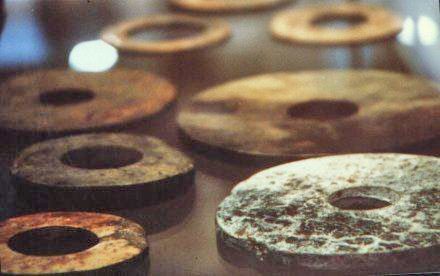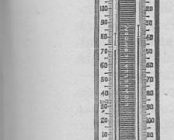The discovery of a mass grave containing dwarfish skeletons with abnormally large skulls in the Bayan Kara Ula Mountains close to the Chinese Tibetan border was not exactly headline news in the January of 1938.
People had other things to worry about back then.
The intrepid archaeologist Chi Pu Tei and his team had found a series of graves aligned in rows inside a cave. The walls were decorated with drawings of stick figures with elongated heads standing under the sun, the moon and the stars. The expedition report stated that the creatures had an unusual skeletal structure like that of flying mammals or birds whose limbs are built to withstand pressure.
They also found an ancient long playing record.
A stone disk was half buried in the dust of the cavern floor. It was a 12 inch with a thickness of about 2/5th of an inch and a hole in the middle large enough to put a finger through. An incised groove spiralled outward from the hole to the perimeter of the disk and then wound its way back in the overall pattern of a double spiral.
Later expeditions discovered a total of 716 such disks from the gravesite. One of them later turned up at the Beijing Academy for Ancient Studies, where Professor Tsum Um Nui became convinced that the groove on the disk was a continuous line of closely written characters. In 1962 he announced that the spiral script contained an account of the crash landing of an alien spacecraft 12,000 years ago, which contained beings known as Dropas who were trapped on earth after the crash and persecuted as ‘evil dwarfs’ by the local Ham tribe.
The Chinese authorities, who first held up the publication of the report then rubbished it, branded Dr. Tsum as a liar and a fool. He was forced to resign and eventually migrated to Japan where he died without recognition of his major discovery.
A group of Russian scientists asked to examine the disks and, after repeated requests, several were dispatched to Moscow. Chemical analysis revealed that large amounts of cobalt and other metallic substances were present in the items. Whoever made the disks wanted them to last.
According to the leading researcher Dr. Vyatcheslav, in a 1964 interview with the Soviet science/propaganda magazine Sputnik, his scientists had managed to create a special turntable to ‘play’ the artefacts. Apparently they emitted an uneven vibration, as if they had been, at one time, exposed to extremely high voltages.
The old capital city of Imperial China, Xian, is home to the 8,000 strong terra cotta army which was created to protect the holy silence of the tomb of Emperor Qin Shi Huangdi. In 1974 the Banpo Museum in Xian also contained two of the stone disks from the Bayan Kara Ula Mountains. A travelling Austrian engineer, Ernst Wenger, took Polaroid shots of, what are now known as, the Dropa Disks.
[box] The stone disks you have mentioned do not exist; but, being extraneous objects in this museum, they were relocated[/box]
The museum director was extremely knowledgeable about all the artefacts under her care but strangely cagey about the origins of the disks, describing them only as ‘cult discs’ and that their true significance was unknown.
The photographs fired the imagination of Hartwig Hausdorf, writer of The Chinese Roswell, who turned up at the Bopan Museum in 1994 with a bunch of questions. The new director Professor Wang Zhijun did not wish to discuss the disks but eventually revealed that following Wegener’s visit in 1974 both the stone disks and the previous museum director had vanished without a trace. He did comment, in typical Chinese double-speak, that ‘The stone disks you have mentioned do not exist; but, being extraneous objects in this museum, they were relocated.’
All of the other disks went missing during the Cultural Revolution and even if one was found you would require the mysterious Russian turntable to play it. Record Collector Magazine does not list the current price of these rare recordings, available, if at all, without cover or inner sleeve. I would imagine that they are not cheap.

Having completed principal photography on phase one of the Sharks revival SWP is now preparing to edit the One Last Thrill feature documentary. Sharks themselves are ‘dropping a big one’ by releasing a double album Dark Beatles/White Temptations in April 2018.
In his spare time the author kayaks the muddy river Ouse and walks the South Downs which gently enfold his home town of Lewes.






















